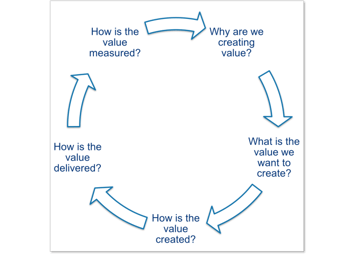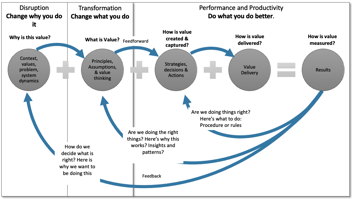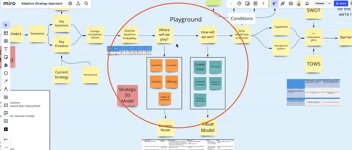In a workshop I attended with Alex Osterwalder, one of the co-creators of the Business Model Canvas, he said that “A business model is like a jug of milk, it goes sour”. In the past, we need to launch new products and services to remain competitive, however, this is now no longer a major differentiator of value. Its not just new products and services that have to be re-invented, but entirely new business models.
Since a business model describes the rationale of how an organisation creates, delivers and captures value, it seems logical that we should not just have a clear view of value and how to measure it, but also a solid understanding of how to create and deliver that value. This is what the value cycle is all about. Pillars to define value, how to create, deliver and capture it. Without concise responses to these questions of value, organisations experience a break in delivering their value outcomes. The break comes in two places:
- A lack of a coherent and consistent definition for each of the value questions. You need to have a consistent definition of what that value is and looks like, as well as a coherency around the attributes of value and how they work together. So for example: To answer the question of “How is the value created?”, you not only need a consistent definition of the strategies being used to create the value, but also an understanding of coherency between those strategies. ie. how do the strategies and tactics work together to create and deliver the value we are looking for.
- A break in the connection between each of the question areas. This means that one part of the business responsible for defining the value, may have limited understanding of how to actually create and deliver that through the capabilities of the business. Therefore a strategy is sufficiently abstracted away from the engine that must deliver the outcomes of that strategy. And the engine is often complicated enough to make the measuring of value outcomes difficult to come by, or least inconsistent across the organization ie. different reports telling conflicting stories when reporting on outcomes.
So the value cycle needs to be coherent, consistent and interconnected. No easy feat in most of the organizations we work in. What might this look like across the questions of the value cycle?:
- Why are we creating value? – this is a question that relates specifically to the values of an organisation and has to do with ideology and beliefs that will ultimately shape the culture of the business. The values dictate how an organization and its staff travel on the path to deliver outcomes for the shareholders or stakeholders. Classic examples of these are integrity, honesty, fairness, pay-it-forward.
- What is the value we want to create? – In short, shareholder or stakeholder related. Is it economic returns such as market share, or is it customer lifetime value through advocacy? These are the attributes that describe value for an organizaton and are often referred to as value drivers. They are the lens that you look through when trying to define your goals and strategies. Its pointless writing goals that won’t help you achieve what you consider to be value, and its also pointless writing goals that may corrupt or compromise your values. Therefore even before you write goals and strategies, you need to be clear on what your values are as well as what you define as value.
- How is the value created? – This is the design of the engine that creates value, and looks at the levers that need to be pulled in order to deliver it. Its a combination of strategies, tactics, value chains, value streams and capabilities, and their different mixes to create differentiation.
- How is the value delivered? – this is the running of the business, and how it delivers the proposed and designed outcomes that business is looking for. It is in this engine that experiences, products and services are used to realise the value that both the organization and the customers are looking for.
- How is the value measured? – finally, “you get what you measure” as the old saying goes. This is the performance model of the business, and the on-the-ground targets and metrics that business uses to determine if the value is in fact being delivered.
I’ll expand on the 5 questions over the next couple of blogs, and look at the pitfalls that occur. The key take away here is that a differentiated business must create an organisation that answers the above 5 questions in a coherent, consistent and interconnected manner. Only then, will true value be realised.
Become part of the discussion on value engines in our TribalMind Journey on creating value engines.




